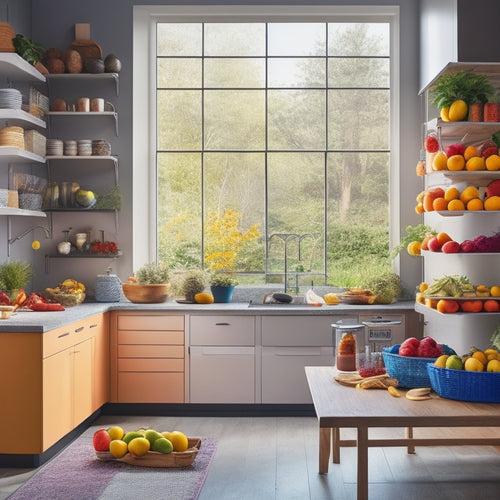
Efficient Tips for Organizing a Commercial Kitchen
Share
To optimize your commercial kitchen's workflow, start by allocating specific areas for different equipment and hanging frequently used tools within easy reach. Organize pantry items by grouping similar items together and consider open shelving and Metro racks for customizable storage. Implement strategic storage systems, labeled containers, and a supply categorization system to maintain a seamless workflow. Carefully plan your kitchen layout to reduce congestion, and assign specific duties to each staff member. By streamlining your kitchen's operations, you'll reduce wait times and increase customer satisfaction - and that's just the beginning of your journey to a more efficient kitchen.
Key Takeaways
• Allocate specific areas for different kitchen equipment and tools to streamline workflow and reduce congestion.
• Implement strategic storage systems, including shelving and labeled containers, to optimize space and reduce waste.
• Organize pantry items by grouping similar items together and using open shelving for easy access and visibility.
• Design a commercial kitchen layout that optimizes space, reduces congestion, and meets health and safety regulations.
• Label stations, color-code equipment, and assign specific duties to staff members to improve workflow and reduce confusion.
Organizing Kitchen Essentials
What's the most effective way to organize your kitchen essentials, and how can you guarantee that everything you need is within easy access when you need it?
To achieve an efficient workflow, allocate specific areas for different kitchen equipment, and hang frequently used essential kitchen tools within easy reach.
Organizing your pantry is vital; implement a system where similar items are grouped together, making it easy to find what you need. Consider open shelving and Metro racks for customizable storage.
Storage Solutions for Restaurants
Optimizing your restaurant's storage solutions is pivotal to maintaining a seamless workflow. By implementing strategic storage systems, you can guarantee that all essential items are readily available when needed.
Consider shelving options that cater to your specific needs, such as adjustable shelves for storing containers of varying sizes. Use storage containers labeled with contents and dates to make easy identification and rotation.
Temperature control is critical for perishable items. Maintain separate storage areas for meat, dairy, and produce to prevent cross-contamination. Implement a food rotation system to secure the First In, First Out method, reducing food waste and maintaining a safe kitchen environment.
Managing Kitchen Supplies
To secure your kitchen runs smoothly, categorize and store supplies in labeled containers, allowing you to quickly identify what you need and maintain a clutter-free workspace.
Implement a supply categorization system, grouping similar items together, such as baking supplies, cleaning products, or cooking utensils.
Use sturdy storage containers with clear labels, making it easy to find what you need in a pinch. This will also help with inventory management, as you can easily track supply levels and avoid shortages.
Setting Up Commercial Kitchens
As you begin setting up your commercial kitchen, careful planning and strategic installation of essential equipment are essential to creating a seamless workflow and guaranteeing a safe, efficient, and profitable operation.
A well-designed commercial kitchen layout is critical to optimize space and reduce congestion. You'll need to install refrigeration units, storage facilities, cooking equipment, and food preparation stations.
Don't forget necessary fire, safety, and sanitation equipment to maintain a safe kitchen environment. Make sure that all equipment is installed according to manufacturer's instructions and meet local health and safety regulations.
Maximizing Kitchen Efficiency
With a well-designed kitchen layout in place, you can now focus on maximizing efficiency by streamlining your workflow, minimizing congestion, and eliminating unnecessary steps.
Implement time-saving techniques like grouping similar tasks together and assigning specific duties to each staff member. Utilize productivity hacks such as labeling stations and color-coding equipment to reduce confusion.
Optimize your space by designating specific areas for food preparation, cooking, and storage. Improve your workflow by positioning frequently used items within easy reach and minimizing walking distances.
Frequently Asked Questions
How Often Should Kitchen Staff Clean and Sanitize Equipment and Utensils?
You should clean and sanitize equipment and utensils after every use, and perform deep cleaning and sanitizing at the end of each shift, following manufacturer guidelines and best practices to guarantee a safe and healthy kitchen environment.
What Are the Essential Items to Stock in a Commercial Kitchen's First-Aid Kit?
You'll be shocked to know that according to OSHA, restaurants experience over 200,000 workplace injuries annually. When stocking your commercial kitchen's first-aid kit, make sure you have supplies like bandages, antiseptic wipes, and pain relievers to comply with regulations and be prepared for emergencies.
Can a Commercial Kitchen Use Second-Hand or Refurbished Equipment to Save Costs?
You can consider using second-hand or refurbished equipment to save costs, but make sure you prioritize equipment maintenance, quality control, and staff training to guarantee safety and efficiency in your commercial kitchen operation.
How Do I Ensure Consistent Food Quality With Varying Kitchen Staff Skills?
You maintain consistent food quality with varying kitchen staff skills by implementing training programs, conducting regular skill assessments, standardizing recipes, and maintaining quality control measures to guarantee a high level of culinary excellence.
Are There Specific Regulations for Kitchen Waste Disposal and Recycling?
As you navigate the complex landscape of kitchen operations, you'll find that waste disposal regulations are the unsung heroes of a safe and sustainable kitchen, with recycling guidelines serving as the guiding light to illuminate your path.
Related Posts
-

Space-Saving Tiered Racks for Kitchen Storage
Space-saving tiered racks are your best solution for maximizing kitchen storage. They employ vertical space, allowing...
-

Ceiling-Mounted Pot Racks for Professional Chefs
Ceiling-mounted pot racks are revolutionary for professional chefs like you. They make use of vertical space, keeping...
-

Wall Racks for Storing Kitchen Herbs and Spices
Wall racks for storing kitchen herbs and spices are a revolutionary advancement for maximizing your kitchen space. Th...


